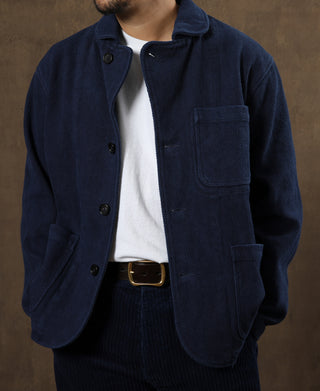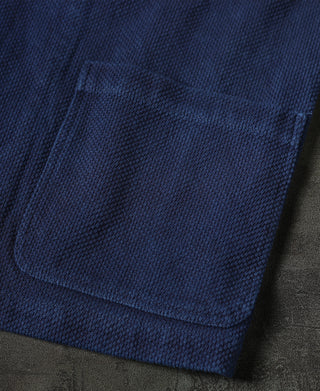Models:
5' 10"/ 178 cm, 160 lbs / 72.5 kg - M (Shown)
This jacket is inspired by workwear, and you can see many workwear details. Made of sashiko cotton with a texturized, woven handle, heavyweight 600 GSM. Hand-dyed using natural indigo and washed. Finished with genuine horn buttons.
- Notch lapels. Three-roll-two silhouette. Genuine horn buttons.
- Long sleeves with clean-finished cuffs.
- Left chest patch pocket.
- Left chest welt pocket. Two front waist patch pockets.
- 600 GSM sashiko cotton, 100% cotton.
- Machine washable.
- Dyed with indigo, which may rub off onto fabrics, leather, and upholstery.
Indigo Garment Care Tips
Always Wash Separately
Indigo will bleed.
First Wash Tips
For first-time wash, soak in warm water with salt for 20 minutes to reduce bleeding and fix the indigo dye.
Daily Washing Guide
Wash in cold water using mild natural detergent (soy-based or wool-safe). Do not bleach or wring. Flat dry in shade.
Indigo fading is a natural characteristic of this fabric. With time and wear, the garment will develop a unique patina — this is a feature, not a flaw.
| Size | Shoulder | Chest |
| S | 18.9" / 48cm | 44.1" / 112cm |
| M | 19.7" / 50cm | 46.5" / 118cm |
| L | 20.5" / 52cm | 48.8" / 124cm |
| XL | 21.3" / 54cm | 51.2" / 130cm |
| XXL | 22" / 56cm | 53.5" / 136cm |
| Size | Length | Sleeve |
| S | 27.2" / 69cm | 23.6" / 60cm |
| M |
27.6" / 70cm | 24" / 61cm |
| L | 28" / 71cm | 24.4" / 62cm |
| XL | 28.3" / 72cm | 24.8" / 63cm |
| XXL | 28.7" / 73cm | 25.2" / 64cm |
In order to best determine fit, it may be helpful to compare our garment’s measurements to a similar garment you already own. Lay your garment on a flat surface and take all measurements from the outside of the garment.
Click here to check out our Garment Measuring Guide.
** If you are still confused, you can Contact Us to help you choose the size. **
- Free shipping on orders $59 (U.S. dollar), Otherwise, a shipping fee of $6.99 will be charged.
- Time Catcher offers 30 day returns. - Return Policy
** All items must be returned in unused, original condition with tags attached. **
Indigo-Dyed Sashiko Work Jacket
- Unit price
- /per
Free Shipping On $59 + Easy 30-day Returns
Have questions? Contact Us
Adding product to your cart
Models:
5' 10"/ 178 cm, 160 lbs / 72.5 kg - M (Shown)
This jacket is inspired by workwear, and you can see many workwear details. Made of sashiko cotton with a texturized, woven handle, heavyweight 600 GSM. Hand-dyed using natural indigo and washed. Finished with genuine horn buttons.
- Notch lapels. Three-roll-two silhouette. Genuine horn buttons.
- Long sleeves with clean-finished cuffs.
- Left chest patch pocket.
- Left chest welt pocket. Two front waist patch pockets.
- 600 GSM sashiko cotton, 100% cotton.
- Machine washable.
- Dyed with indigo, which may rub off onto fabrics, leather, and upholstery.
Indigo Garment Care Tips
Always Wash Separately
Indigo will bleed.
First Wash Tips
For first-time wash, soak in warm water with salt for 20 minutes to reduce bleeding and fix the indigo dye.
Daily Washing Guide
Wash in cold water using mild natural detergent (soy-based or wool-safe). Do not bleach or wring. Flat dry in shade.
Indigo fading is a natural characteristic of this fabric. With time and wear, the garment will develop a unique patina — this is a feature, not a flaw.
| Size | Shoulder | Chest |
| S | 18.9" / 48cm | 44.1" / 112cm |
| M | 19.7" / 50cm | 46.5" / 118cm |
| L | 20.5" / 52cm | 48.8" / 124cm |
| XL | 21.3" / 54cm | 51.2" / 130cm |
| XXL | 22" / 56cm | 53.5" / 136cm |
| Size | Length | Sleeve |
| S | 27.2" / 69cm | 23.6" / 60cm |
| M |
27.6" / 70cm | 24" / 61cm |
| L | 28" / 71cm | 24.4" / 62cm |
| XL | 28.3" / 72cm | 24.8" / 63cm |
| XXL | 28.7" / 73cm | 25.2" / 64cm |
In order to best determine fit, it may be helpful to compare our garment’s measurements to a similar garment you already own. Lay your garment on a flat surface and take all measurements from the outside of the garment.
Click here to check out our Garment Measuring Guide.
** If you are still confused, you can Contact Us to help you choose the size. **
- Free shipping on orders $59 (U.S. dollar), Otherwise, a shipping fee of $6.99 will be charged.
- Time Catcher offers 30 day returns. - Return Policy
** All items must be returned in unused, original condition with tags attached. **

Sashiko
Sashiko (刺し子, lit. 'little stabs') is a type of traditional Japanese embroidery or stitching used for the decorative and/or functional reinforcement of cloth and clothing.
First coming into existence in the Edo period (1603–1867), sashiko embroidery was first applied to clothing out of a practical need and would have been used to strengthen the homespun clothes of olden times. Worn-out clothes were pieced together to make new garments by using simple running stitches. These clothes increased their strength with this durable embroidery. By the Meiji period (1868–1912), sashiko had been established enough to evolve into winter work in northern farming communities when it was too cold to work outside.
Sashiko was commonly used to reinforce already-patched clothing around points of wear, but it would also be used to attach patches to clothing, ultimately making the fabric stronger. It would also be used to layer thin fabrics to create warmth and, in the case of some garments such as the coats of firemen, to create a thick and absorbent material that would be soaked in water before carrying out duties as a fireman. Though most sashiko utilizes only a plain running stitch technique, sashiko is commonly used to create decorative and repeated embroidered patterns and may be used for purely decorative purposes, such as in the creation of quilts and embroidery samplers.

Indigo Dye
The first discovery of indigo-dyed fabric dates back to Peru, around 6000 years ago. The ancient art of natural dyeing, particularly with indigo, has its roots in China and Africa, with China being renowned for its exceptional techniques.
Unlike chemical dyes, which produce a single tone, the natural dyeing technique reveals a rich spectrum of colors. From delightful blues to cloudy grays, each plant imparts a unique hue that chemical dyes can't replicate. This characteristic lends itself to personalization, changing with wear to create a unique appearance. The process, from plant picking to creating the dye, is time-consuming. The final color is influenced by the specific parts of the plants chosen for the dye. Each dyeing process requires multiple water rinses until the color becomes solid and rich.














